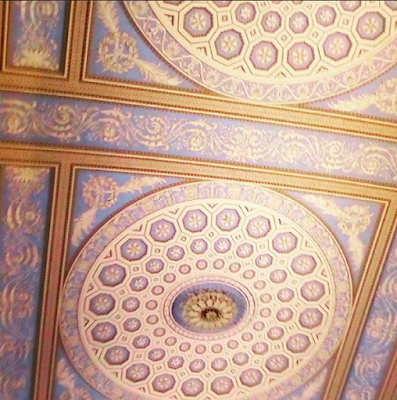Little London stories (part 3 of 5): The Painted Hall Ceiling
I'm a proud graduate student at King's College London in the Eighteenth-Century Studies programme. I was first admitted clear back in 2009, deferred numerous times, reapplied, was readmitted, deferred again and again and now, am finally here. So of course I am thrilled, especially on days like last Wednesday.
We joined one of our convenors, Emrys Jones, from King's at the
Painted Hall at the Old Royal Naval College grounds in Greenwich.About a third of the class made it out there on a very cool day and it was worth each
shivering moment out on the grounds, a World Heritage Site in western London.
The soaring eighteenth-century buildings were originally constructed for the Royal Hospital for Seamen at Greenwich, which was designed by Christopher Wren, and built between 1696 and 1712. Wren also designed dozens of churches peppered throughout London, most notably the rebuilt St. Paul's Cathedral. The hospital closed in the mid 1800's and was shortly thereafter converted to a naval training facility, but that also would eventually close.
What made the hairs on my Yankee arms stand on end, though, was knowing that the site was originally the Palace of Placentia, or "Greenwich Palace", and the birthplace of Tudor queens Mary I and Elizabeth I. Our guide from King's told us it was a favourite palace of that Royal charmer, Henry VIII. These days the site is wildly popular for movie locations including parts of "The Queen" and one of my favourites, "Four Weddings and a Funeral."
The purpose of our visit was to take a tour of the Painted Hall and more specifically, the Painted Ceiling. We also
toured the adjacent elaborate chapel, which unlike U.S. churches I've visited from the period, lacked stained glass windows. Our prof. had warned us we must be able to walk up 70 steps, not be pregnant or have any other glaring health conditions. I considered my rickety right knee carefully, but chose instead to get a glimpse of brilliance. Smart move.
We were
this close to Sir James Thornhill's masterpiece, viewing
Greek gods and goddesses such as Diana and Hercules; geographical sites like The City of
London and the Thames; and a spruced up (according to the guide) version of King William III, a dashing black-haired leading man alongside wife Queen Mary II. Thornhill, according to legend, made a pound per square foot. These days, people are paying a lot more than that to sponsor the restoration.
The Painted Hall is undergoing a facelift; parts of it are falling apart. Up close we could see snags. Over the years, centuries really, repairmen and maybe women have made their mark on the grand painting. In one spot, our guide showed us where some joker had posted his initials on a woman's bust. Ahem.
London is full of so many treasures it's sometimes impossible to take a moment, breathe, and realize this is not everyday life. But last Wednesday, on the grounds of the Royal Naval College in Greenwich, I took a breath. Thanks, Emrys, for a day I and my classmates will always remember.
For more information, to book a ceiling tour (highly recommend it!) or sponsor part of the restoration,
visit the Old Royal Naval College website.
PHOTOS: Top 3 by Laurie Wiegler; bottom: By Gryffindorderivative work, https://commons.wikimedia.org/w/index.php?curid=10147824







Comments
Post a Comment